Rupert Matthews's Blog, page 34
November 23, 2012
Some peculiar gladiators
Women gladiators were rare
They first appeared in around ad55 when they performed in Rome as a novelty act. The women fought only other women or took part in fights against animals. Women gladiators were more popular in the eastern parts of the Empire. They were banned in ad200 by the emperor Septimius Severus.
The andabatae gladiators fought blindfolded
The Romans loved anything new or bizarre. The andabatae gladiators were specially trained men who wore helmets with no eye holes at all. They listened carefully for sounds of their opponent, then attacked with two swords. Sometimes the andabatae fought on horseback.
from "100 Facts You Should Know about Gladiators" by Rupert Matthews.
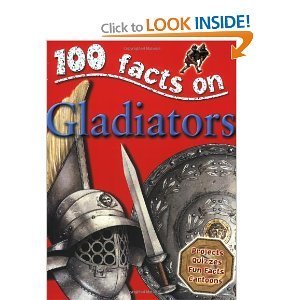
Buy your copy HERE
Book Description
Publication Date: 1 Jan 2007 | Series: 100 Facts
Discover everything you need to know about gladiators with this brilliant book.

Published on November 23, 2012 01:01
November 22, 2012
Aztec Weaponry
Spears were thrown at the start of a battle. The Aztec people built up a large empire in what is now Mexico between 1400 and 1510. Their warriors won a series of battles in these years against other American peoples. Each battle began with men on both sides throwing light javelin at the enemy. Then the men would charge at each other to fight at close quarters.
Obsidian stone was razor sharp. The Aztec, Maya and other peoples of America did not know how to make iron or bronze, so they made their weapons out of wood, stone and other natural materials. The most effective weapons were edged with slivers of obsidian, a very hard stone that has a very sharp edge when first broken.
Spears were tipped with stone. Spears were often tipped with flint, which was easier to shape and found in greater quantities than obsidian. These spears were designed to wound the enemy so that he could not fight so well.
from "100 Things You SHould Know About Arms and Armour" by Rupert Matthews
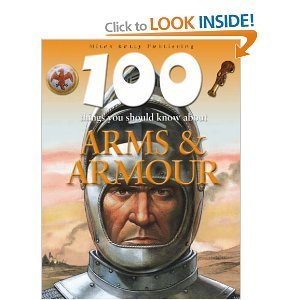


Obsidian stone was razor sharp. The Aztec, Maya and other peoples of America did not know how to make iron or bronze, so they made their weapons out of wood, stone and other natural materials. The most effective weapons were edged with slivers of obsidian, a very hard stone that has a very sharp edge when first broken.
Spears were tipped with stone. Spears were often tipped with flint, which was easier to shape and found in greater quantities than obsidian. These spears were designed to wound the enemy so that he could not fight so well.
from "100 Things You SHould Know About Arms and Armour" by Rupert Matthews


Published on November 22, 2012 02:13
November 21, 2012
Ironclad Rams - a revolution in naval warfare?
The technological
improvements in steel shipbuilding combined with revolutionary gun
manufacturing techniques would revolutionize naval warfare between 1870 and
1890, but the true importance of the changes in weaponry would not become
apparent until the Great War of 1914-18.
Warships had been carrying iron amour since the 1850s and the first
all iron warship was the British HMS Warrior
of 1860. These early ironclads, as they were known, carried a similar armament
to warships of three centuries earlier: a number of muzzle-loading guns
arranged to fire outward from the sides of the ship.
It quickly became apparent that the old style weaponry was
effectively useless against the new style armor. At the same time coal-fired
steam engines were replacing sails as the main means of locomotion for
warships. Compared to a sailing ship, a steam ship needs no masts and far fewer
men, but it does need large below decks space for the engines and the coal
needed for long voyages. These factors resulted in a series of sometimes
bizarre experimental designs.
One idea was to abandon guns when fighting a rival ironclad and
instead ram the enemy. The US Civil War saw some early experiments in ramming,
but it was the Austrians who first used the weapon with real success. At the
Battle of Lissa on 20 July 1866 Admiral Tegetthoff with a fleet of seven
ironclads and assorted wooden support vessels attacked an Italian fleet under
Admiral di Persano who had 12 ironclads plus several wooden warships.
Tegetthoff ordered his ironclads to fire only at the enemy wooden vessels and
to engage the rival ironclads by ramming. Within under an hour the Italian
flagship and another ironclad were sent to the bottom of the Adriatic. The
Austrians lost no ships, though one was damaged and a few men killed.
The world’s navies hurriedly began building ironclads with
vicious-looking metal rams attached to greatly strengthened bows. The fashion
for rams lasted about 20 years before admirals realized that the maneuvers
needed to get a ram into action were unlikely ever to produce results in a
battle where the enemy was aware of the danger, as Persano had not been in
1866.
[image error]
Battle of Lissa

Published on November 21, 2012 01:21
November 7, 2012
An Interrupted Wedding in 1588
[image error]
In Dell Quay to the southwest of Chichester is a shingle foreshore and a small harbour where some yachts and other pleasure boats are usually to be seen. This quiet spot was once, like Bosham, a busy port. In the medieval period the river up to Chichester silted up so much that ships could no longer reach the town. They loaded and unloaded their cargoes here instead.
Leave Dell Quay by the only road. At a T-junction turn right along the A286 to pass through Birdham, then continue along the B2179 to pass through West Wittering and then into East Wittering. At a T-junction turn left to join the B2198, then take the first right. Just after this lane turns sharp left, turn right to follow a twisting lane to Sidlesham. After about 2 miles you will need to turn sharp right along a lane signposted to Sidlesham.
Arriving in Sidlesham you should cross over the B2145 to enter a short lane that leads to the little church, scene of a dramatic wedding in 1588. On 4 August the local villagers gathered here to celebrate the wedding of a local farmer's daughter to a sturdy local yeoman. Ever since the spring of 1587 the local men had been practicing military drilling in anticipation of an expected Spanish invasion, and the groom was a sergeant in the local militia. His comrades turned up to the wedding to wish him well. The service had just begun when the ominous sound of distant gunfire was heard. The officer, eager not to interrupt the wedding, ordered the men to stay in the church. Just as the service ended, a horseman came clattering up. It was the lookout who had been stationed on Selsey Bill. Breathlessly he reported that the vast Spanish Armada was in battle with the English fleet off the Bill. The men grabbed their weapons, fell in and marched off for Bognor. The groom went with them. All were grateful when the great Armada stood out to sea, heading southwest. The young groom could return to the arms of his new wife.
from "Teashop and Pub Drives in Sussex" by Rupert Matthews.
Buy your copy HERE

Book Description
Publication Date: 15 April 2010
If there are two marvellous things about England that can
be found nowhere else on earth, they are pubs and tearooms. Both types
have their fans but together they sum up so much about England that is
special and unique. And Sussex had some of the finest in the kingdom.
With seventeen drives designed to start with a light lunch, then
afterwards, a leisurely drive through the beautifiul Sussex countryside.
Finally stopping off for afternoon tea. What better way to spend an
afternoon!


Leave Dell Quay by the only road. At a T-junction turn right along the A286 to pass through Birdham, then continue along the B2179 to pass through West Wittering and then into East Wittering. At a T-junction turn left to join the B2198, then take the first right. Just after this lane turns sharp left, turn right to follow a twisting lane to Sidlesham. After about 2 miles you will need to turn sharp right along a lane signposted to Sidlesham.
Arriving in Sidlesham you should cross over the B2145 to enter a short lane that leads to the little church, scene of a dramatic wedding in 1588. On 4 August the local villagers gathered here to celebrate the wedding of a local farmer's daughter to a sturdy local yeoman. Ever since the spring of 1587 the local men had been practicing military drilling in anticipation of an expected Spanish invasion, and the groom was a sergeant in the local militia. His comrades turned up to the wedding to wish him well. The service had just begun when the ominous sound of distant gunfire was heard. The officer, eager not to interrupt the wedding, ordered the men to stay in the church. Just as the service ended, a horseman came clattering up. It was the lookout who had been stationed on Selsey Bill. Breathlessly he reported that the vast Spanish Armada was in battle with the English fleet off the Bill. The men grabbed their weapons, fell in and marched off for Bognor. The groom went with them. All were grateful when the great Armada stood out to sea, heading southwest. The young groom could return to the arms of his new wife.
from "Teashop and Pub Drives in Sussex" by Rupert Matthews.
Buy your copy HERE

Book Description
Publication Date: 15 April 2010
If there are two marvellous things about England that can
be found nowhere else on earth, they are pubs and tearooms. Both types
have their fans but together they sum up so much about England that is
special and unique. And Sussex had some of the finest in the kingdom.
With seventeen drives designed to start with a light lunch, then
afterwards, a leisurely drive through the beautifiul Sussex countryside.
Finally stopping off for afternoon tea. What better way to spend an
afternoon!

Published on November 07, 2012 00:05
October 31, 2012
Eton opposes a railway line 1835
Meanwhile, the Windsor council had given support to the newly formed London and Windsor Railway Company. This company aimed to build a line from the capital to Windsor by way of Osterley as the first stage of a much grander route down to the southwest of England. A key problem was that the route envisaged crossing Royal lands. King William IV was consulted and gave his permission for a line to be built over the Home Park so that it entered the town by way of Datchet Lane.
Eton, as ever, opposed the construction of a railway anywhere near the College. The influence exercised by the college on peers of the realm, together with growing worries over the financial stability of the project, ensured that the London and Windsor Railway Bill was defeated in the House of Lords.
The GWR promptly put forward a new Bill to Parliament seeking permission for its own branch line to be constructed along roughly the same lines as previously envisaged. Eton objected again, though a newly elected council at Windsor did not. The Bill was passed by Parliament, but only after Thomas Carter, Provost of Eton, had managed to get so many restrictions and conditions imposed that the GWR judged the project to be commercially unviable. Once again the branch line idea was dropped.
from "Lost Railways of Berkshire" by Rupert Matthews
Buy your copy HERE
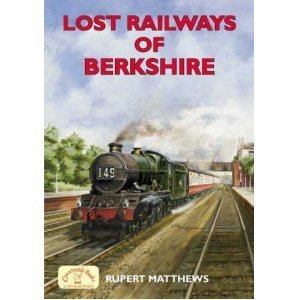
Book Description
Publication Date: 4 Oct 2006 | Series: Lost Railways
This illustrated book covers the history of the county's
railways from construction in the 1840s to, in many cases, closure in
the 1960s. It includes Brunel's GWR mainline and branch lines to
Windsor, Wokingham and Bracknell, Cookham and Steventon.


Eton, as ever, opposed the construction of a railway anywhere near the College. The influence exercised by the college on peers of the realm, together with growing worries over the financial stability of the project, ensured that the London and Windsor Railway Bill was defeated in the House of Lords.
The GWR promptly put forward a new Bill to Parliament seeking permission for its own branch line to be constructed along roughly the same lines as previously envisaged. Eton objected again, though a newly elected council at Windsor did not. The Bill was passed by Parliament, but only after Thomas Carter, Provost of Eton, had managed to get so many restrictions and conditions imposed that the GWR judged the project to be commercially unviable. Once again the branch line idea was dropped.
from "Lost Railways of Berkshire" by Rupert Matthews
Buy your copy HERE

Book Description
Publication Date: 4 Oct 2006 | Series: Lost Railways
This illustrated book covers the history of the county's
railways from construction in the 1840s to, in many cases, closure in
the 1960s. It includes Brunel's GWR mainline and branch lines to
Windsor, Wokingham and Bracknell, Cookham and Steventon.

Published on October 31, 2012 01:05
October 29, 2012
Leicestershire Local Food
[image error]
My wife was living in Bottesford in the Vale of Belvoir when we met. We were married there in the magnificent church that goes by the name of The Lady of the Vale of Belvoir, and our daughter was christened in the same place.
My wife introduced me to the delights of a Melton Mowbray Pork Pie on an early date while we were courting, and later showed me that there are two sorts of cheese known as Stilton - I had previously thought that there was only one. She has collected a number of recipes over the years and some of these are included in this book. I must also thank many other people who have helped with this book. It would be an impossible task to list them all, though you will find many of them listed as makers of fine foods and drinks at the back of this book. I must single out Angela Geary who has kindly allowed me access to her collection of old Leicestershire lore, including recipes and information on fruit varieties.
I have enjoyed researching this book, and must confess that my trousers are a touch tighter now than when I started.
Read, Eat, Drink, Enjoy.
from "Food and Drink of Leicestershire" by Rupert Matthews.
Book Description
Publication Date: 1 Jun 2009 | ISBN-10: 0752448633 | ISBN-13: 978-0752448633
 Leicestershire holds an important place in the history of
Leicestershire holds an important place in the history of Britain's food. This exploration of the county's fare sets food and
drink against the character of Leicestershire to discover how history,
landscape and culture have shaped the county's diet. Combining tales of
the creation of Leicestershire's most famous dishes with recipes that
show off the quality of the local produce, the story of the
Leicestershire's historic market towns and celebrated livestock farming
is discussed in detail, giving a clear explanation of how world-renowned
delicacies such as the Melton Mowbray pork pie, and both Stilton and
Red Leicester cheese, have made their name. Illustrated with detailed
images of their creation, and of course mouth-watering photographs of
the final product, this book will inspire chefs far and wide. Whether a
resident of Leicestershire or merely a fan of its food and drink, this
book is a must-have for all those who appreciate the fine traditions of
the county's cuisine.

Published on October 29, 2012 01:08
October 27, 2012
Hitler's first strategic mistake
As early as 1914, when a rumour swept his regiment that they were to land in England, Hitler had turned his mind to considering invading Britain. The rumour turned out to be false and Hitler spent the next four years in the trenches in France. But in 1940 he was faced with the prospect of fighting a war against Britain and was forced to try to find a way to defeat that country.
The main problem he confronted was that neither he nor anyone in the German military had expected to face a war against a Britain determined to resist. Hitler had never had any intention of attacking Britain nor any part of her empire, it simply was not part of his plan for conquest in the East. Although he had expected Britain to object to his aggresion and, perhaps, even to declare war, Hitler had believed that Britain’s essential interests were not threatened by his actions. He had reasoned, therefore, that Britain would make peace once his conquests were an established fact.
It was the first real strategic failure that Hitler made in his military career. He had expected Britain to make peace. When she did not he had no pre-planned brilliant operation ready to knock her out of the war. The second, and much greater, strategic mistake was to follow the next year. With Britain still unsubdued, Hitler expanded the war by invading Russia. He had said before the conflict started that he would first have to ensure peace in the West before attacking East. He did not do so. Arguably this cost him his victory.
from "Hitler - Military Commander" by Rupert Matthews
buy your copy HERE
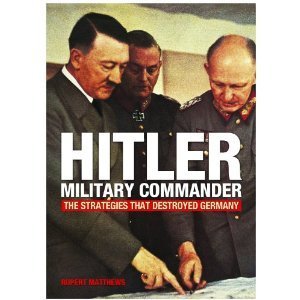
Product Description
Synopsis
Offering an entirely new perspective on one of the world's most
notorious dictators, HITLER Military Commander breaks new ground in this
pithy and revealing analysis by Rupert Matthews, one of the foremost
military history experts on this period. Containing previously
unpublished accounts of Hitler's apparent descent into madness, it
examines the relationship between Hitler the man and Hitler the leader,
and charts the spectacular rise and fall of the Axis fighting force
under the control of the non-German former corporal.


The main problem he confronted was that neither he nor anyone in the German military had expected to face a war against a Britain determined to resist. Hitler had never had any intention of attacking Britain nor any part of her empire, it simply was not part of his plan for conquest in the East. Although he had expected Britain to object to his aggresion and, perhaps, even to declare war, Hitler had believed that Britain’s essential interests were not threatened by his actions. He had reasoned, therefore, that Britain would make peace once his conquests were an established fact.
It was the first real strategic failure that Hitler made in his military career. He had expected Britain to make peace. When she did not he had no pre-planned brilliant operation ready to knock her out of the war. The second, and much greater, strategic mistake was to follow the next year. With Britain still unsubdued, Hitler expanded the war by invading Russia. He had said before the conflict started that he would first have to ensure peace in the West before attacking East. He did not do so. Arguably this cost him his victory.
from "Hitler - Military Commander" by Rupert Matthews
buy your copy HERE

Product Description
Synopsis
Offering an entirely new perspective on one of the world's most
notorious dictators, HITLER Military Commander breaks new ground in this
pithy and revealing analysis by Rupert Matthews, one of the foremost
military history experts on this period. Containing previously
unpublished accounts of Hitler's apparent descent into madness, it
examines the relationship between Hitler the man and Hitler the leader,
and charts the spectacular rise and fall of the Axis fighting force
under the control of the non-German former corporal.

Published on October 27, 2012 05:48
October 25, 2012
Marooning
Apart from death, the worst punishment pirates gave each other was marooning. A pirate who stole from his comrades was put ashore on a remote island and left. Men marooned on small islands usually died of starvation, but some survived for years. Alexander Selkirk was marooned on Juan Fernandez in 1705 and rescued in 1709. His story is the basis of the famous novel ‘Robinson Crusoe’, by Daniel Defoe.



Published on October 25, 2012 02:15
October 24, 2012
Cardigan and the cardigan
James Brudenell, 7th Earl of Cardigan earned great fame as the man who led the heroic, but futile Charge of the Light Brigade at the Battle of Balaclava in 1854. He was one of the richest men in Britain and spent a fortune equipping his regiment, the 11th Hussars, with the finest equipment and uniforms. He insisted on aristocratic manners and once courtmartialled an officer or ordering beer, instead of wine, at dinner. He challenged another to a duel for turning up for dinner with improperly polished buttons. Undoubtedly brave, his prickly temperament and unpopularity with more senior officers led to his retirement in 1866. The cardigan, a knitted jumper that buttons up the front, was named in his honour.
from "Heroes, Rascals and Rogues" by Rupert Matthews
Buy your copy HERE

Book Description
Publication Date: 1 Nov 2008
Written by expert authors Rupert Matthews and John
Birdsall, this highly illustrated guide, with photos and memorabilia of
people who have made their mark on history, includes key entries on each
individual, with boxes and biographies about competitors or
co-conspirators. With more than 400 extraordinary people in total it is a
fascinating look at some of the most colourful characters in history -
from ancient times right up-to the present day. Discover why Caligula
was mad, what made Napoleon seek to conquer, and who was really was the
most outlawed cowboy in the West.But, on the flip side of 'the coin of
fame', meet the people who have made their name by heroic acts or
astonishing feats of human endeavour. Find out who first broke the
four-minute mile, and what drove him on; which astronaughts have been
lucky enough to view the Earth from space; and who is the youngest war
hero ever to be decorated. "Heroes, Rascals and Rogues" takes a look at
some of the most unconventional people to have lived among us, in an
easy-to-read, illustrated format with interesting facts and figures that
will make this book hard to put down.


from "Heroes, Rascals and Rogues" by Rupert Matthews
Buy your copy HERE

Book Description
Publication Date: 1 Nov 2008
Written by expert authors Rupert Matthews and John
Birdsall, this highly illustrated guide, with photos and memorabilia of
people who have made their mark on history, includes key entries on each
individual, with boxes and biographies about competitors or
co-conspirators. With more than 400 extraordinary people in total it is a
fascinating look at some of the most colourful characters in history -
from ancient times right up-to the present day. Discover why Caligula
was mad, what made Napoleon seek to conquer, and who was really was the
most outlawed cowboy in the West.But, on the flip side of 'the coin of
fame', meet the people who have made their name by heroic acts or
astonishing feats of human endeavour. Find out who first broke the
four-minute mile, and what drove him on; which astronaughts have been
lucky enough to view the Earth from space; and who is the youngest war
hero ever to be decorated. "Heroes, Rascals and Rogues" takes a look at
some of the most unconventional people to have lived among us, in an
easy-to-read, illustrated format with interesting facts and figures that
will make this book hard to put down.

Published on October 24, 2012 02:01
October 23, 2012
RAF in Sussex "in the thick of it" - 1940
The fall of France and the entry of Italy into the conflict profoundly altered the entire balance of the war. Italy’s army may not have been of high quality, but its fleet and air force was. Suddenly the entire Mediterranean became a war zone as the Royal Navy struggled with the Italian Navy and air force for control of the vital sea lanes. Closer to home, German warships and U-boats now had the use of France’s Atlantic ports, putting them much closer to the convoy routes across the Atlantic on which Britain relied.
Of rather more concern to the men of RAF Fighter Command in Sussex was the fact that the Luftwaffe was now based just over the Channel instead of hundreds of miles away in Germany. Enemy bombers would no longer be coming from the east with limited flying time over Britain, they would now be coming from the south with hours of fuel to spare. More worryingly, the bombers could now be escorted by the short-range single-engined Messerschmitt Bf109 in large numbers, not only by the less nimble twin-engined Messerschmitt 110 fighter.
Sussex was now right in the front line. Soon the RAF bases there would be in the thick of it.
from "Heroes of Fighter Command: Sussex" by Rupert Matthews
Buy your copy HERE
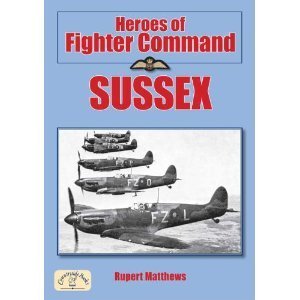
Book Description
Publication Date: 11 Oct 2007 | Series: Aviation History
Throughout the second half of the 1930's, war with Germany
seemed increasingly likely. The RAF, preparing for the coming
struggle, formed Fighter Command in July 1936 under the legendary Air
Marshal Sir Hugh Dowding. In this well researched and excellently
written book Rupert Matthews tells the story of courageous individuals
whe despite the odds, flew mission after mission during the 2nd World
War.


Of rather more concern to the men of RAF Fighter Command in Sussex was the fact that the Luftwaffe was now based just over the Channel instead of hundreds of miles away in Germany. Enemy bombers would no longer be coming from the east with limited flying time over Britain, they would now be coming from the south with hours of fuel to spare. More worryingly, the bombers could now be escorted by the short-range single-engined Messerschmitt Bf109 in large numbers, not only by the less nimble twin-engined Messerschmitt 110 fighter.
Sussex was now right in the front line. Soon the RAF bases there would be in the thick of it.
from "Heroes of Fighter Command: Sussex" by Rupert Matthews
Buy your copy HERE

Book Description
Publication Date: 11 Oct 2007 | Series: Aviation History
Throughout the second half of the 1930's, war with Germany
seemed increasingly likely. The RAF, preparing for the coming
struggle, formed Fighter Command in July 1936 under the legendary Air
Marshal Sir Hugh Dowding. In this well researched and excellently
written book Rupert Matthews tells the story of courageous individuals
whe despite the odds, flew mission after mission during the 2nd World
War.

Published on October 23, 2012 01:47

















